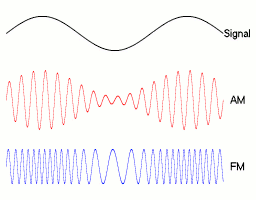In the last post we introduced the concept of modulation as one of the five meanings of the term mode. Voice is the most common and obvious mode of modulation so let’s dive into that a bit as it is one of the basic concepts of amateur radio.
Modulation is the means to impress information on a radio signal. It’s how a circuit puts our voice onto the radio signal through a microphone.

If you are (or were) fortunate enough to receive US Technician license training using the ARRL course book and companion slides you would find some good info as follows:
When information is added to the radio wave, (the carrier) we modulate the wave.
•Turn the wave on and off (Morse code)
•Speech or music
•Data
In the physics of waves there are three characteristics we might control to impart information (three possible modulation methods or modes).
Different modulation techniques vary different properties of the wave to add the information: amplitude, frequency, or phase.
These three are commonly known as Amplitude Modulation (AM), Frequency Modulation (FM), and Phase Modulation (PM).
AM is relatively easy to understand and visualize. The RF carrier wave is varied in amplitude according to the audio waveform (as from a microphone) to create a modulated signal.


Amplitude modulation is commonly used on the familiar AM broadcast band. It may occasionally be found on lower frequencies in the HF ham bands. While it used to be the primary mode of voice communication in the early years, very little pure AM is used nowadays in favor of single sideband (SSB), which is a type of AM.

SSB is a big and important topic which merits its own write-up so we will post that soon.
FM is less intuitive and harder to visualize than AM. The RF carrier is varied in frequency according to the audio waveform (as from a microphone) to create a modulated signal.

Frequency modulation is commonly used on the familiar FM broadcast band and in ham radio above 28MHz for high quality simplex and repeater operation.

PM is very similar to FM in the way it operates with only a technical difference between the two (integration of the baseband signal). Here the RF carrier is varied in phase according to the audio waveform, instead of the frequency.

Despite the terminology, many (most?) FM radios we routinely use for local communications over repeaters use PM circuitry. The two are effectively equivalent for ham radio use; interesting discussion here and even more detailed one here.
For the ham radio operator, AM and FM are the two main voice modulation modes to understand. SSB and PM are simply sub-sets or derivations. This animated graphic is particularly helpful in visualizing AM vs FM:

Useful comparisons between the two (applies equally to broadcast and ham radio):
- AM has poorer sound quality (narrow bandwidth); FM better quality (wider).
- AM is prone to noise interference; FM is relatively immune to electrical noise.
- AM has narrower bandwidth (more efficient) than FM (trade-off with sound quality)
- AM circuitry is simpler and cheaper than FM
- With AM, transmitted power level varies with the amplitude of the signal; with FM transmitted power level is constant, regardless how much modulation (deviation) is applied.
In context of voice modulation, bandwidth means the range of frequencies the signal occupies.
Because of these differences in bandwidth and efficiency, AM and FM are generally used on different Continue reading
